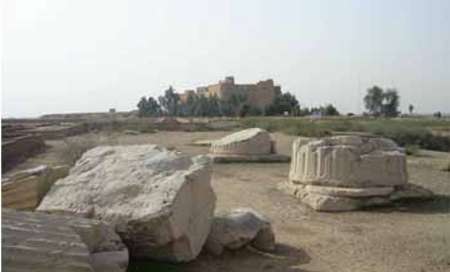
RICHT quoted Faramarz Tathiri Moqaddam as highlighting the point while speaking at the third specialized session under the title “retrofitting historical buildings against earthquake” held by the Institute’s research center of historical-cultural buildings and textures.
First, he referred to an article in relation to the extraordinary retrofitting method used in the foundations of the Persepolis and how integrated slab stones used in many layers have practically provided seismic isolation for the Achaemenid palace.
The expert added: “Of course in my familiarity with the Persepolis since a long time ago under the supervision and direct training of Professor Shapour Shahbazi in the years 1345-46 (1966-67) and remarks of that prominent master, he had somehow referred to the point but due to my incomplete knowledge I had not been able to make a proper analysis of the issue but later, and after acquaintance with the result of different earthquakes, the issue appeared to me with a special significance.”
Pointing out that the advanced knowledge of seismology in the world has reached the solution with different technologies, he said: “Unfortunately, such methods have not been customized in our country the way it should be and even in our neighborhood in the Persian Gulf (littoral states) or in Turkey some of these methods are being practiced.”
The architect engineer while referring to the different method used in the Susa palace since a long time ago, i.e. the Achaemenid, in retrofitting the foundations said the lasting buildings have been completed in accordance with the base isolation method.
He went on to outline the methods used in the Susa palace and said the Susa plain with giant rivers such as Karkheh, Dez, Shaour and finally Karoon is one of the most vintage bio zones in the area.
For this same reason, he added, the primary Susa hills generated establishment of the Ilamites for more than 2200 years in this plain and in the point of Susa (as the capital city of the Ilamite Empire).
The expert, noting that after the destruction of the adobe buildings in that era, the primary dunes became more prominent and the secondary dunes were created, adding that for the location of the grand Achaemenid palace in Susa due to the abundance of water from Shaour and other springs, the Susa royal seat should have been established over the hills.
Therefore, on the old soil of the former residential hills, a genius measure was taken and in order to avoid the risk of seasonal flooding of the rivers, they applied river rocks to the hills (in holes up to the depth of 6 to 8 meters and on bumps up to 2 meters) in order to cover the surface with stone slabs brought from the Lorestan mountains in a distance of 120 to 160 km.
Pointing to the possibility of the drift of the lower layers as a result of the loading of the structures of the Apadana royal seat, he said for controlling the slide and stabilizing the royal seat platform a belt of 5 meters thick and 5 meters high was made out of adobe and brick which is indicative of the relative awareness of the performance of the inner forces of the earth in making the foundations of the grand palace.
He further remarked that more interestingly, in order to avoid penetration of moisture in the fortress, the first several layers of the foundations of the walls (belt) were made with baked bricks and bitumen mortar in dimensions more than 40x40x10 cm and thereby created a retrofitting mass resistant to the drift of the hill of the royal seat.
Another speaker of the session was Narjes Divdar who elaborated on her research for increasing resistance of the historical texture of Oudlajan district on the basis of the landscape of a historical city of UNESCO 2011 and said the research was aimed at finding a process to increase the resilience of the historical texture of Oudlajan.
She referred to the Oudlajan district as the main historical center of the city of Tehran and the unit of cultural, historical and natural values, adding that vulnerability of this historical texture against earthquake has resulted in the destruction and vast and irregular reconstruction.
Meanwhile, Arash Rahgozar, a post-graduate student of urban development in Tehran University, said there are a large number of mosques, schools and other cultural monuments throughout the country, which date back to hundreds of years ago in which bricks with traditional mortars of mud, lime and gypsum have been implemented.
He noted that in order to protect these buildings against earthquake sufficient information should be collected on characteristics of the materials to take measures for retrofitting the buildings.
Referring to the plan for the improvement of the Faculty of Law of University of Tehran against earthquake, he said the building is one of the oldest centers of higher education in Iran which was opened under the orders of Mozafareddin Shah Qajar under the name School of Political Science in 1287 (1908/09) and the present building of the faculty became operational in 1313 (1934/5).
9376**1771
www.irna.ir
 solhkhabar | Peace International News Agency Peace International News Agency , Peace News , International Agency News of Peace
solhkhabar | Peace International News Agency Peace International News Agency , Peace News , International Agency News of Peace